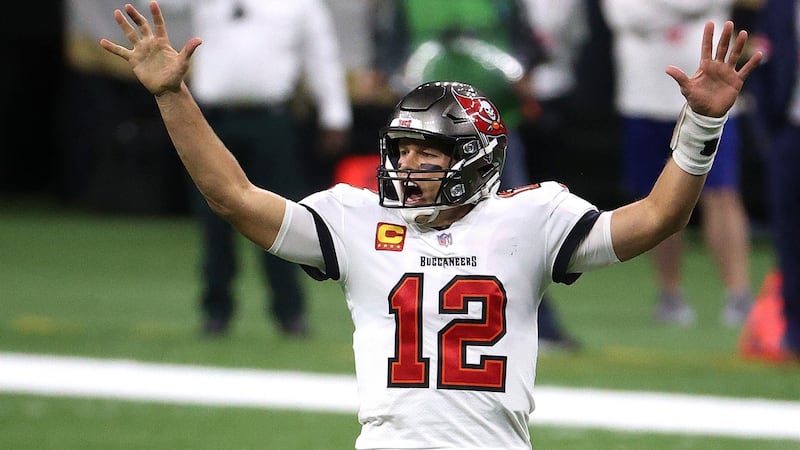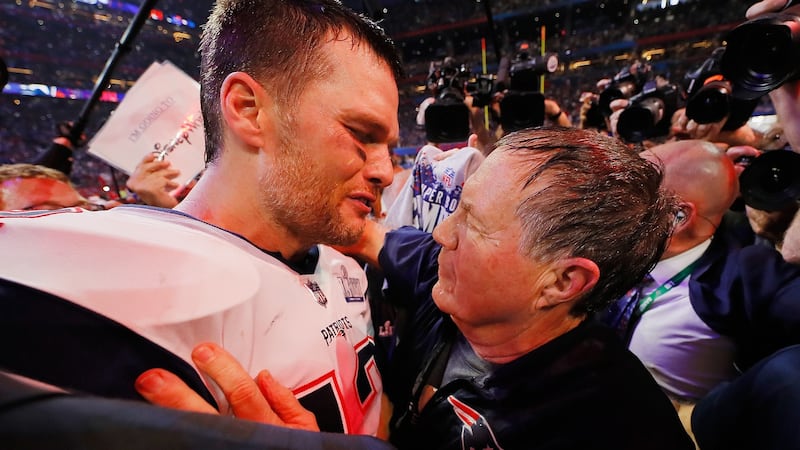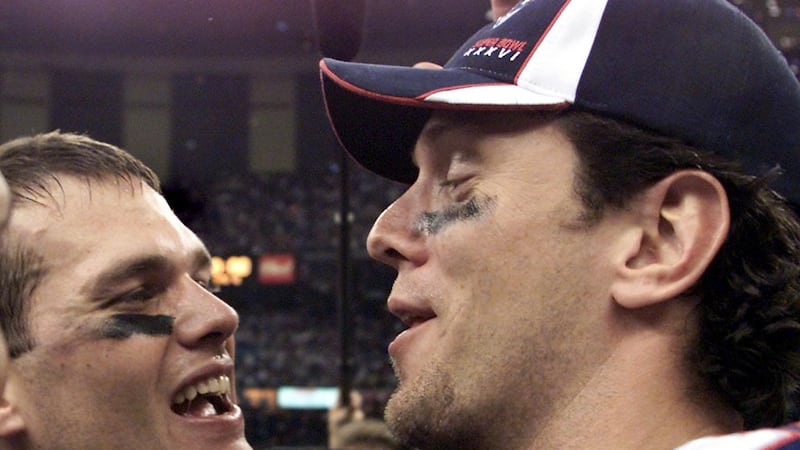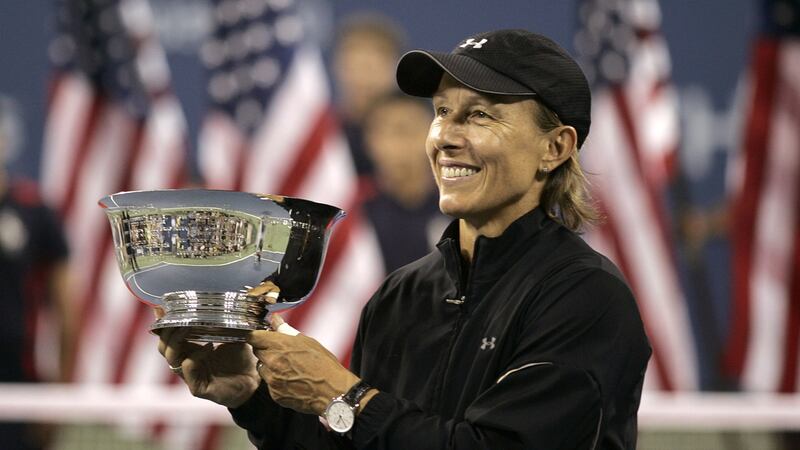They are expecting snow showers and bitterly cold playing conditions of minus two in Green Bay, Wisconsin on Sunday evening. Lambeau Field is one of those cathedrals of world sport, bright and cold and vitally independent.
So it’s an appropriate setting for what feels like a spine-tingling occasion: America watching, calmed by the old reassurance of a brand new president, settling down on a pandemic winter Sunday night to watch on as the most enduring figure in American sport attempts to do it all, one more time.
When Tom Brady, who has electrified the Tampa Bay Buccaneers in his first season and Aaron Rodgers, the Green Bay Packers quarterback since 2005, take the field, they will form the oldest combined age for starting quarterbacks in a conference championship game in NFL history. They have played against one another just three times in their NFL careers and this, remarkably, will be their first playoff meeting.
Both men grew up close to San Francisco and both were cut to the quick to be passed over by their childhood team, the 49ers. Both are inscrutable and all-time greats. Rodgers is 37 and long established as an introspective and singular figure in American sport and one of the most unorthodox players the game has seen.
But Brady is 43 years old. He stands alone. In a career defined by an imperious defiance of all expectations, he is on the threshold of another impossible achievement. His tenure as the best quarterback in the game is now traversing through its fourth presidential administration: George Bush and Barack Obama both spent two terms in the White House and the Age of Trump has come and gone while Brady has remained an emblem of stubborn exacting excellence and the face of the team that America loved to hate.
He already stands as the oldest quarterback to play in a Super Bowl, aged 41 in his ninth and final appearance with the New England Patriots, whom he had led to six championships. Brady’s decision to leave New England, after 19 years caused a ‘shock’ in the sporting sense. But it happened last March, when the world was engulfed in the virus and sport in general was rightly pushed to the periphery of concerns. The decision to sign with the terminally mediocre Buccaneers was even more perplexing and the general assumption was that he would fade out.
Brady’s first game with Tampa Bay ended in defeat. They were playing against the New Orleans Saints in September and going into the third quarter it was easy to imagine Bob Kraft, the Patriots owner and Bill Belichick, the bellicose head coach, nodding in quiet satisfaction at their prudence.
Tampa Bay had fallen into a 24-7 hole and Brady was floundering. Here was substance to the theory that without the safety net of Belichick’s dictatorial coaching and the Pats empire behind him, Brady would become human and vulnerable. But that evening was an illusion. A week later, they won and kept winning. In the distracted winter season of 2020, Brady took up where he left off, slinging passes and conjuring wins and looking dauntless as ever in the new uniform.

A fated symmetry has detailed Brady’s career and inevitably his team met New Orleans again, in the divisional round knock-out game last Sunday. This time, the results were reversed. The defeat was almost certainly the final game for Brady’s old foe Drew Brees, who came into the NFL a season after Brady and was a Super Bowl winner in 2010.
About an hour after that game, someone shot footage of Brees lingering on the Superdome field with his wife and children. Brady appeared, in street clothes, his gear bag slung over his shoulder. The two players had a long, friendly conversation, embraced and then Brady threw a football for one of the Brees children to catch in the end zone. Because the moment wasn’t choreographed, it contained a rare, evocative power.
The clip went viral. It was one of the few times in 20 years that Brady had been truly captured as a person rather than as all-conquering Pats quarterback. And it prompted a quick and instant national reimagining of Brady: even devoted Brady-haters came to Twitter to announce that they dug the scene.
It’s a full 10 years since the Bleacher Report gleefully reported that Brady was ranking among the most hated figures in the NFL. “Could this be true? Pretty Boy Tommy being hated nationwide?” By 2019, a Twitter survey on players loved, liked, disliked or hated ranked Brady in a different realm, hated in 30 different states.
The reason for Brady’s status as comic-book villain was obvious: he had won too much for too long. The Patriots dynasty was oppressive and its haughtiness – the Patriot Way – rankled. But here was a different Brady, gone from the Patriots, carving a solo path with a modest team. And the sight of him walking away under the sodium lighting, in the aching loneliness of an empty stadium, revived the question of what Brady represents – and who he is.
Though the story of his unlikely rise has been well documented, its fabulousness deepens with every passing season. In the many documentaries about Brady – and ESPN is finishing a nine-part deep dive to be broadcast this year – there features grainy footage of Brady’s high school coach trying to convince college coaches of his prospects. Brady had started his football career on a school team that played eight, lost eight and scored no touchdowns. And he was the reserve quarterback: he only made the team because the starter quit in disillusionment.
He forced his way from reserve to starter in college at Michigan but the NFL scouting reports were scathing of his chances as a professional: poor build, skinny, lacking mobility and strength, a really strong throwing arm, no tight spiral on the ball. “That sounds like Joe Montana to me,” Brady would say a decade later when it was read to him. Famously, he was selected 199th, in the sixth round, by the Patriots in the NFL draft of 2000: a day that had begun in high hopes slid into dejection, fear and, finally, tears of relief.
“It was just a tough day,” he would recall.“I just remember being with Mom and Dad. And finally the Patriots called and I was so excited. I was like: I don’t have to become an insurance salesman, you know.”

He didn’t have to become Willie Loman. But he wasn’t supposed to become anything special, either. The source of Brady’s invincible self-belief has never been adequately explained. From the beginning, he behaved as if the past two decades have simply been the fulfilment of a manifest destiny.
The story of how he has introduced himself to Patriots owner Kraft at a pre-season workout has become part of the lore. “You’re Tom Brady,” Kraft said. “Yes, and I’m the best decision this organisation has ever made.” It sounds corny, like one of the more pumped lines from the Tom Cruise oeuvre. Except that it did happen – and was completely prescient.
America was still numb and reeling from the 9/11 atrocity when New York Jets defensive tackle named Mo Lewis clattered into Drew Bledsoe of the Patriots on September 23rd, 2001. The force of the hit caused a sheared blood vessel in Bledsoe’s chest: it could have killed him. And it gave Brady the opening he needed.
It is easily forgotten that the Patriots had decided that Bledsoe was their quarterback future, agreeing a $103 million, 10-year contract the previous March. The idea was to tie him into the team for the remainder of his career.
Bledsoe’s adolescent experience had been the opposite of Brady’s. He starred- at everything, feted as a basketball, football and track star, lionised in college and selected as the number one draft pick in 1993 where he began transforming the moribund Patriots into a real force.
Bledsoe was amicable and complacent. He liked Brady, the young understudy because of his sunny disposition and eagerness and politeness but never saw him as starting material. There’s a haunting few seconds of footage where Bledsoe talks Brady through the playbook, asking him what he likes and is visibly taken aback by the energy and speed of the back-up’s reply. “You just want to throw and get on television, right,” he jokes. Brady murmurs in assent but his face is hidden. Then came the Lewis tackle and Brady stepped confidently into Drew Bledsoe’s beautiful future and made it his own.
Bledsoe started one game that year, replacing the injured Brady to guide the Patriots through the championship game. But despite the lavish contract and his nominal place as first-choice quarterback, he did not play in what was the Patriots’ first Superbowl win. He left New England in 2002, graceful and vanquished. Bledsoe’s story is hardly a tragedy: he retired as a multi-millionaire and now enjoys a second life as a wine producer in California, from where he periodically gives interviews on the Brady phenomenon with no evident sense of torture or regret.
Oddly, the Bledsoe experience may well have been the thing that frightened Belichick and Kraft from ever committing to the long-term contract that Brady had repeatedly and publicly desired. For the past decade, his contract negotiations were terse and linked to bonus initiatives. Kraft has long made a virtue of the Patriots ‘family’ and while Brady was its most starry member, the elders didn’t share his view that he could play on until his mid-40s. They were unceremonious and unsentimental when it came to Bledsoe. And two decades on, the Patriots were just as cold in their appraisal of Brady’s longevity. They wouldn’t commit money to seasons he may never get to play.

By the time Brady left the Patriots, anybody with the faintest interest in sports or pop culture knew the skeleton details of Brady's public life: that he was the winner's winner with a daytime-soap smile, that he was married to former supermodel and entrepreneur Giselle Bundchen and that he has, for the past few years, been obsessed with defying time.
A tailored docu-series, Tom versus Time, chronicled his journey through football, life, spirituality and family and advocated his late-career fitness epiphany based on muscle pliability regime and a tailored diet – he’s death on strawberries and the nightshade family in general and can’t get enough artichokes.
The strange friendship with Donald Trump is mystifying: it’s impossible to see where their values overlap and it left Brady exposed to criticism when Trump transmogrified from reality star businessman to president elect. The only true explanation is that Brady’s sincerity – his politeness and his utter lack of cynicism led him to accept Trump as he found him rather than what he heard and read about him. But ultimately nobody knew. For beneath the helmet and pads, Brady has remained stubbornly opaque.
The quarterback is one of the few emblems of American male masculinity that has travelled unassailed through into the 21st century. Even before this season, Brady’s statistics and longevity had him at the top of the pile of iconic names – Montana, Elway, Unitas, Starr, Staubach, Marino; football quarterbacks who came to define eras in American life.
But Brady has been there for so long and has been curiously ageless along with excellence, that it is only now, this winter, that Americans are beginning to realise that despite having this man beamed into living rooms for 20 winters, he remains enigmatic. He is 43 and shouldn’t still be dominating in a sport where some of the best athletes in the country are paid to hit him and to hurt him.
“The NFL is an absolute bottom line business,” said Tee Martin, one of the six quarterbacks drafted ahead of Brady in the 2000 draft.
“You get it done or . . . you’re not there anymore.”
That’s the brutal environment through which Brady has been a blaze unconfined. And it’s why his unexpected presence in Lambeau Field on a glacial Sunday evening, is, in a morale-battered time, a true marvel: a moment in time.

Longevity legends
Football Stanley Matthews played his 699th and final game for Stoke City in 1965 in a 3-1 win against Fulham. He was 55-years-old.
Tennis Although Martina Navratilova won her last Grand Slam singles title at the age of 33, she won her final title, the 2006 US Open mixed doubles, at the age of 49.
Ice Hockey Gordie Howe played in five decades of NHL All Star games in a career that stretched from 1945-1980, during which he established himself as one of the greatest players in the game and gave name to the Gordie Howe hat-trick, which includes a goal, an assist and a fight in the same game.
Baseball Satchel Paige had played for 17 years in the Negro Leagues before becoming the oldest rookie to play in the major leagues aged 42. He pitched his final game in 1965, at the age of 59. However, three years later the Atlanta Braves president William Bartholomay signed him as a part-time pitcher so that Paige could fulfil the 158 days he needed to draw down his major league pension.
Racing
Lester Piggott came out of a five-year retirement in 1990 and won the Breeders’ Cup Mile 10 days after returning to the sport. He rode his last Classic winner, Rodrigo de Triano, in the 2000 Guineas in 1992 at the age of 57. He officially retired in 1995, just before his 60th birthday having been the British Flat racing champion jockey 11 times over a career spanning five decades.















